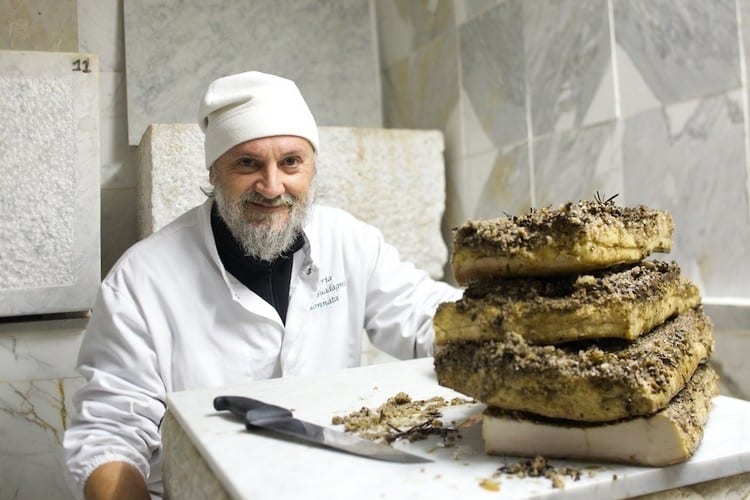
Lardo di Colonnata
The village of Colonnata is perched at 500ms in the Apuan mountains above Carrara, northern Tuscany. It’s mining history dates to the 6th Century BC but in the last 30 years the most famous, pure white 'statuario' marble has been mined out. Today the village has become almost as well known for its lardo as for its marble.
Lardo is the cut of fat from the top of the pigs’ back, a vestige from the past when their wild ancestors had a thick shield of fat to protect them as they moved through thick undergrowth. Over the centuries this cheap cut became a kitchen staple villages across the Apuans. Work in the quarries was incredibly arduous and preserving lardo in marble tanks provided miners with a cheap, available source of energy.
Our lardo comes from Fausto Guadagni whose family has lived in Colonnata for centuries and whose parents were the first to sell their lardo when the first road to the village was built in the 1950s.
Fausto started making Lardo di Colonnata in the 1990s and has worked with the same Mantova farm for the last 20 years. He collects the fresh cuts every week, covers them with sea salt and leaves them for 24 hours. The best salt comes from cold water seas with a lower salt saturation and lots of trace elements (Maldon would be Fausto’s preference but, given that he uses 20kg for every 100kg of meat, it is too expensive!).
For each new batch the marble tank in which the lardi are aged is cleaned with water and vinegar then rubbed with garlic. No temperature control is used during the ageing process nor any type of preservative added so the tank is incredibly important; all are made with marble from the Canaloni vein to the east of Colonnata for a dry, fine grain stone that makes a perfect, breathable container. Today food safety requirements increasingly ask for polished marble tanks but Fausto still uses some that are centuries old and have been hewn by hand to retain a diverse colony of flavour boosting microflora.
With the lardo and the tank prepared the final step is the cure. There are 3 ingredients common to all producers: black pepper, rosemary and fresh garlic but after that each will have their own secret mix of herbs and spices. Fausto uses rosemary, bay, garlic, thyme, nutmeg star anise, garlic, pepper and cinnamon in his Lardo di Colonnata but experiments with ginger, calvados, dried apples, capers or balsamic vinegar in others. The cure is placed in alternating layers with the lardo and, when full, the tank is closed with a marble lid for 10 -12 months.
During that time a magical thing happens in the tank which Fausto likens to the process of enfleurage. This centuries old method of making perfume sees animal fat spread on a flat surface and ingredients such as flower petals pressed into it. The petals are left for 48 hours, replaced with fresh and the process repeated for 40 days until the fat is completely saturated with fragrance. At this point the perfume oils are separated from the fat using alcohol. Lardo is similarly spongelike and, after 10 months in the marble tank, is totally saturated with the perfume and flavours of Fausto’s mistura or cure. The fibres have also broken down to create a texture like chilled butter. True Lardo di Colonnata is incredibly important both culturally and gastronomically and there is nothing else quite like it. Fausto's family own Locanda Apuana, a wonderful restaurant just inside the village walls and if you're lucky enough to go to Tuscany do try and get there. Just make sure you're hungry when you do.

